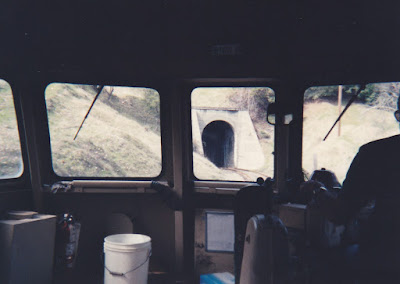The California Western Railroad was originally built in 1885 by the Fort Bragg Lumber Company as the Fort Bragg Railroad. In 1904, passenger service was inaugurated. On July 1, 1905, the railroad was renamed the California Western Railroad & Navigation Company. The railroad was completed to Willits and a connection with the Northwestern Pacific Railroad on December 11, 1911. Self-propelled gas-powered railcars were added for passenger service in 1925, they were nicknamed "skunks" because of the smell of their exhaust. The "skunks" soon took over passenger service, and regular steam-powered passenger train service ended in November 1929. On December 19, 1947, the name was shortened to California Western Railroad. In June 1987, the California Western was sold to Kyle Railways.

California Western motorcar M-300 waits in front of
the Fort Bragg depot on March 18, 1992, for passengers to board for the trip to Willits. M-300 is a Motorailer built by American Car & Foundry in 1935 as Seaboard Air Line #2026. It was the third of a group of three built for the Seaboard. It became Aberdeen & Rockfish #106 in 1944 and then became Salt Lake, Garfield & Western MC-3 in 1951. It was purchased by the California Western in 1963.
M-300 is pictured at Northspur. Northspur is the midpoint of the line, where the train makes a
brief stop.
At one point the railroad goes around several
horseshoe curves, and another part of the line appears to be a parallel track. This is one of the five horseshoe curves with a total length of 6.5 miles required to climb 932 feet between two points 1.5 miles apart.
Here is a view from the train as it
approaches Tunnel #2, the second of the two tunnels on the line. This tunnel is 795 feet long and was completed in 1911.
Here is the train’s engineer at
the controls of the M-300.
Here is the interior
of motorcar M-300 as we travelled, showing a light passenger load on a March weekday.
Here is a horse along the line as the train approaches Willits.
As the train enters Willits, the railroad crosses California State Route 20. At this point the highway crosses Broaddus Creek, which parallels the railroad here.


















